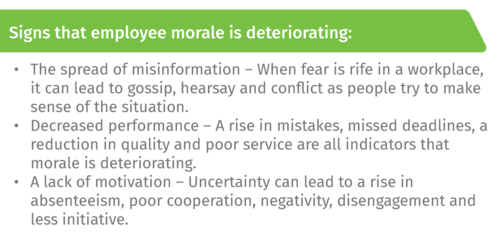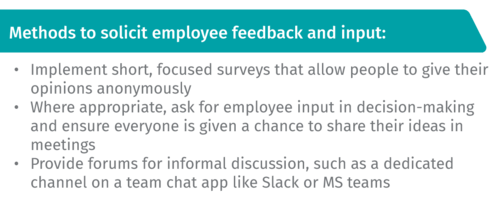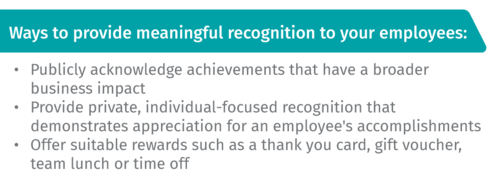News & Insights
< Back to Blogs
Managing Employee Morale Amid Uncertainty: 3 | Enterprise IT Resources

COVID-19 has taught us many lessons in a very short time, and one of the key things it has highlighted is how rapidly change can occur. Uncertainty has always been part of the business world, and it’s safe to assume it will remain that way long after this situation has passed.
The effects of uncertainty can quickly trickle down to the workforce and lead to significant issues with employee morale and productivity. As a result, it’s vital that leaders understand how to identify and lessen the impact of uncertainty to help their businesses withstand challenges – both now and in the future.
3 Signs that Employee Morale May Be Suffering
As uncertainty grows within an organisation, it can drastically impact the mood of the team. However, leaders can learn to recognise morale issues and tackle them head-on to prevent them from negatively affecting the business in the long term.
Here are some of the biggest red flags to watch out for.
Some of these signs may not be immediately obvious or could come on gradually, particularly if there is a disconnect between management and the rest of the team. However, time and change (such as a return to the office environment after working remotely) can bring these issues to the forefront, so it’s important to be actively monitoring your team for red flags to pinpoint them before they become bigger problems

Actionable Steps to Improve Morale
In uncertain times, leadership determines whether a business can rise above the challenges and continue to move forward, or if it will bow to the growing pressures.
To help you respond to the warning signs and keep your team engaged, we have put together some tips on how to boost employee morale amid uncertainty.
1. Stay in tune
When comes to dealing with uncertainty in business, it’s vital for leaders to constantly stay “tuned in” to the perceptions and needs of their team, especially during crisis events such as COVID-19 where the circumstances can change in an extremely short time.
Being visible and present allows you to better understand the way the uncertainty is disrupting your business and what you need to do to address the problems.
Aim to regularly check in with employees to gauge the general “mood” of the team, gauge morale and provide opportunities for people to raise issues such as feeling overwhelmed by their workload. An easy way to do this is to implement a (realistic) open-door policy, but don’t forget to actively solicit questions and provide opportunities for feedback through avenues such as anonymous employee surveys as well.
2. Be honest and transparent
Transparent communication is a cornerstone of managing employee morale during uncertainty. People will often be confused, fearful and will look for reassurance around the future of the company and their roles, so a leader must be ready to provide that sense of security wherever possible.
However, that doesn’t mean being overly optimistic or sugar-coating reality – negating the facts of a serious situation could make you appear out of touch and will only exacerbate the fears of your team.
Instead, acknowledge that the uncertainty exists, show that you are aware of the difficulties people are facing and provide a plan to manage them. Remember – you don’t have to have all the answers, you just need to be honest and demonstrate that you are prepared to respond to challenges as they arise.

3. Celebrate success
Everyone wants to know their work is appreciated, and in uncertain times, acknowledging the efforts of the team is even more important for boosting morale and making employees feel valued. By recognising success, you can reassure people that progress is being made, even during a difficult time.
Take every opportunity to celebrate wins and achievements, no matter how small. Look for ways to recognise accomplishments with low-cost awards, bonuses and praise – you could even hold a weekly meeting or video call to highlight team members that have made a positive contribution and share recent success stories.
Don’t forget to ensure that everyone knows what is expected of them and involve individuals in setting targets and KPIs – this will keep goals realistic and help people stay focused and motivated despite the circumstances.

Summary
Regardless of the industry you’re in, uncertainty will always be an issue that businesses must deal with, so knowing how it could impact your team and how to respond is key. Whilst there are many ways to improve employee morale, the focus should ultimately be on making people feel valued, secure and engaged.
For advice on growing your team in an uncertain time or support with your next IT recruitment drive, please don’t hesitate to reach out to us.

Share This Article
Recent Articles

Filter By Category
Subscribe to our News & Advice












